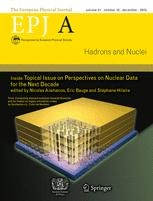Oct 19 2016
Regardless of the scenario, breaking up is dramatic. Take for example the case of carbon (12C) splitting into three nuclei of helium. Until now, due to the poor quality of data and limited detection capabilities, physicists did not know whether the helium fragments were the object of a direct breakup in multiple fragments up front or were formed in a sequence of successive fragmentations. The question has been puzzling physicists for some time. Now, scientists from Denmark's Aarhus University have used a state-of-the-art detector capable of measuring, for the first time, the precise disintegration of the 12C into three helium nuclei. Their findings, released in a study published in EPJ A, reveal a sequence of fragmentations, relevant to developing a specific kind of fusion reactions and in astrophysics.
 Credit: Springer
Credit: Springer
Excited states of 12C that split into three helium nuclei were first intensively investigated by the Nobel Laureate Ernest Rutherford and his colleague Mark Oliphant in 1933. When atoms break up into smaller parts, the manner in which energy is distributed between the fragments contains in itself information on how the atom fell apart. Seeking a better understanding of the nuclear structure as well as the arrangement of protons and neutrons, the authors focus on detecting data following the splitting of the carbon (12C) into three helium nuclei, which is interpreted as a reaction between protons and an isotope of Boron (11B). By comparing their detection data with the existing breakup models, the authors confirmed the hypothesis of a sequential scenario and refuting that of a direct breakup.
Their findings could have applications in devising an alternative to neutron-producing fusion reactions, a process called aneutronic fusion. In addition, they could help to improve our theoretical understanding of an extremely important reaction in astrophysics: the time-reversed process involving the fusion of three helium nuclei into 12C.